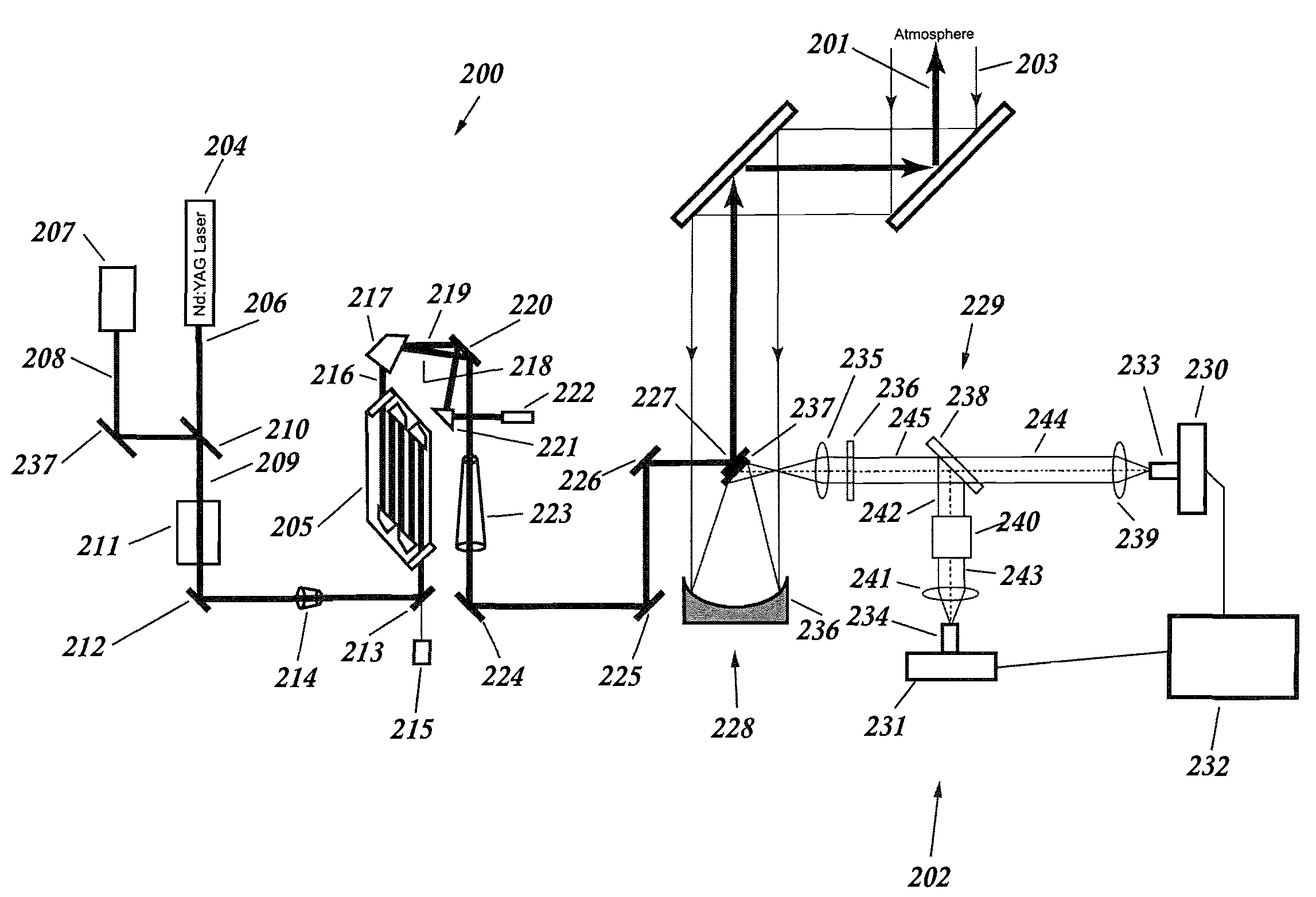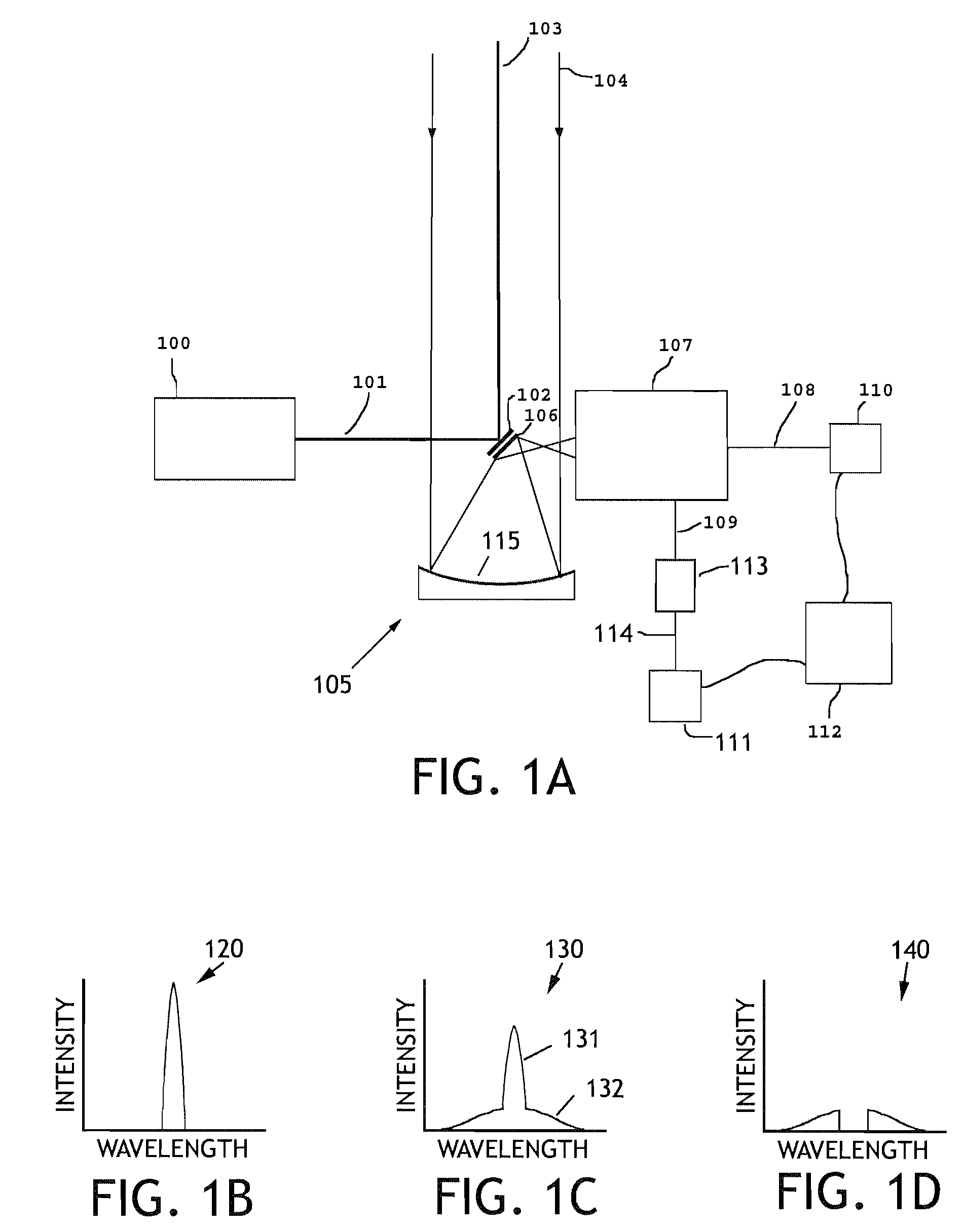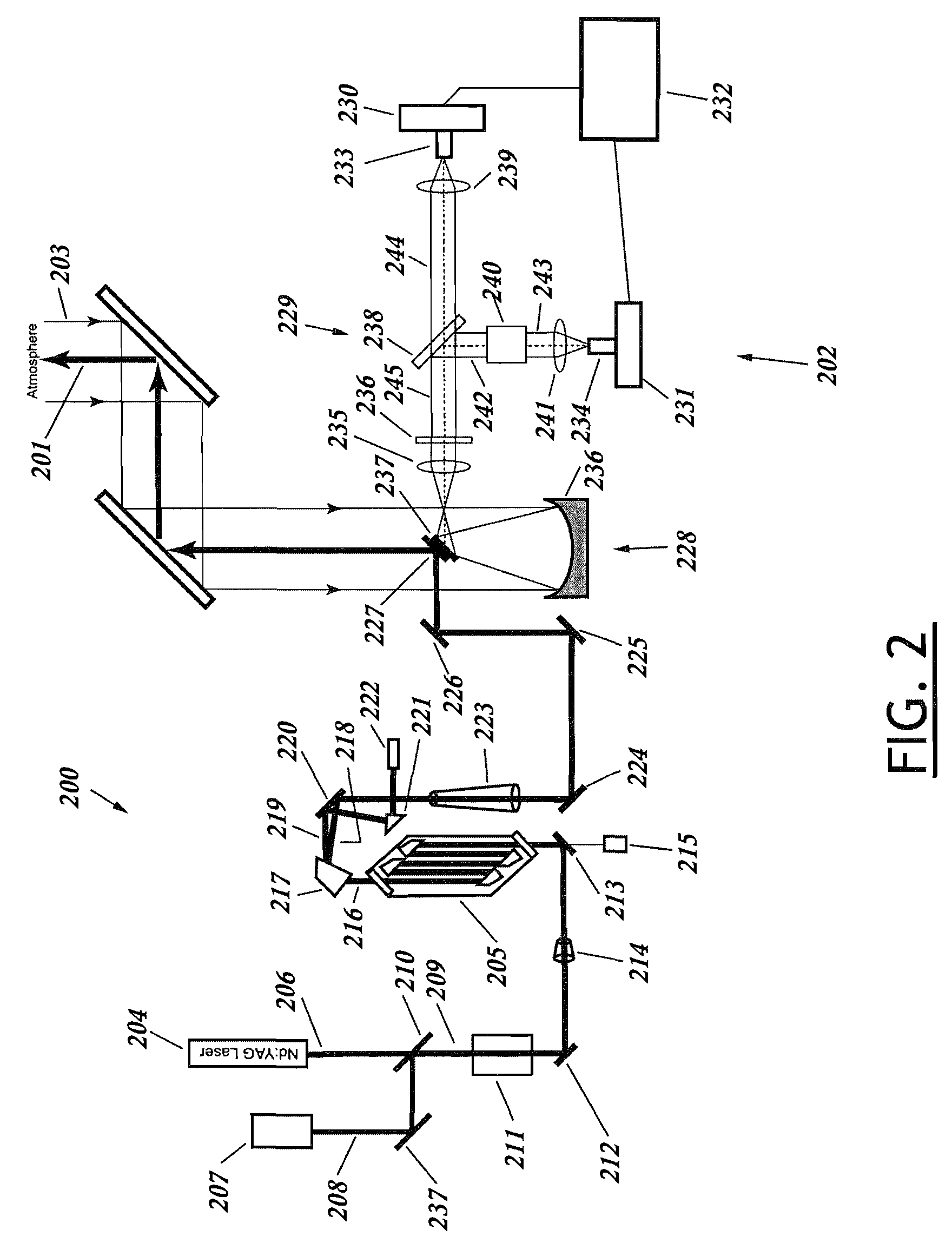[0009]The present invention relates to a
lidar system, lidar system components, and associated methodologies for remote measurement of absolute aerosol backscatter coefficients. In particular, one embodiment includes a
transmitter that enables transmission of an eye-safe, high
pulse energy,
narrow bandwidth, and
optical beam. A
receiver and processor capable of distinguishing molecular scattered (e.g., Rayleigh scattered)
radiation from aerosol scattered (e.g., Mie scattered)
radiation is provided, enabling the determination of absolute aerosol backscatter coefficients. This is accomplished by filtering out the
aerosol scattering component of the detected backscattered
radiation. The aerosol-scattered component is extremely spectrally narrow and corresponds to the aforementioned
narrow bandwidth transmission
wavelength. The remaining scatter detected is substantially the molecular scattering component of the backscatter. At a known
temperature and pressure, the molecular
backscatter coefficient can be predicted. The
aerosol scattering component can be measured by subtracting the molecular scattering component from the total backscatter measured. The remainder will substantially be the
aerosol scattering component of the backscatter. From the measured molecular and aerosol scattering components and the molecular
backscatter coefficient, a calibrated, absolute aerosol backscatter coefficient can be calculated.
[0011]An embodiment of the present invention is capable of helping to determine particle concentration when certain characteristics, such as size distribution and scattering efficiency, of the type of aerosol particle present in the atmosphere are known. Knowing particle concentration can be valuable when, for example, determining the amount of
pollution being emitted from an
industrial facility or determining the amount of ash or dust from a
natural disaster. Concentration level information can be particularly critical when the atmospheric aerosol particles are harmful, intentionally released biological, radiological or
chemical agents. Concentration levels, plume location and plume movement would be valuable to emergency responders to help determine evacuation areas and routes, predict health effects on the endangered
population and direct
emergency response efforts.
[0012]The present inventors have recognized that there exists a need for a remote absolute aerosol particle backscatter coefficient
identification system that can safely, quickly and efficiently identify the aerosol scattering component of backscattered radiation without the need for extraordinary safety precautions or lengthy time-averaging of backscattered radiation to achieve acceptable
signal-to-
noise ratios. The present inventors have also recognized the need for a remote absolute aerosol particle backscatter coefficient
identification system that can scan the atmosphere at a rate sufficient enough to provide accurate and timely information about the structure and movement of the aerosol particles.
[0013]Accordingly, one embodiment of the present invention is capable of rapidly determining a calibrated, absolute aerosol backscatter coefficient from the backscattered radiation of a transmitted pulsed beam. The backscattered radiation may be integrated over a very short period of time, e.g. a single or small number of pulses. One implementation is capable of determining a calibrated, absolute aerosol backscatter coefficient of aerosol plumes from a single laser pulse to ranges of several kilometers. This is possible because of the high
pulse energy which generates sufficient backscatter signal that can be distributed across at least two detectors (e.g., unfiltered or combined channel and filtered or molecular channel) from a
single pulse. Because of the high pulse energy, analog direct detection can be used in the system as opposed to
photon counting receivers used in known, relatively low pulse energy HSRL systems. This enables the embodiment to scan significant sections of the atmosphere in a timely manner. This further enables the present embodiment to provide data that can be used to generate a dynamic representation of the absolute aerosol backscattering attributes of aerosol particles in large sections of the atmosphere. Also it is beneficial that the system is capable of operating in an eye-safe mode in that it produces an energy output within the eye-
safety standards of American
National Standard for the Safe Use of Lasers, ANSI Z136.1-2000, which is incorporated herein by reference.
[0015]Furthermore, the present inventors have recognized that it would be useful to remotely parameterize aerosol particles in multiple ways. Accordingly, embodiments of the present invention may be integrated into a system of remote aerosol
particle identification and tracking. Other parameters, such as, for example,
fluorescence and
depolarization characteristics, may, in combination with the aerosol scattering information, aid in identifying unknown aerosol particles. This remote parameterization can be accomplished by the analysis of returned radiation from transmitted radiation that interacts with atmospheric aerosol particles to determine aerosol particle parameters such as, for example,
particle density, optical thickness, particle shape, particle behavior and
chemical composition. The analysis can be comprised of examining such characteristics as molecular and aerosol scattering (as presented herein),
depolarization,
fluorescence, wave properties, and other optical phenomenon. The analysis of the molecular and aerosol scattering attributes of backscattered radiation to remotely determine aerosol particle characteristics described herein is a promising aspect of the broader ability to remotely characterize atmospheric aerosol particles using a transmitted beam of radiation.
[0028]In accordance with a further aspect of the present invention, a methodology is provided for remotely measuring atmospheric molecular scattering. The methodology comprises transmitting an
optical beam having a primary
wavelength of between about 1.5 and 1.8 microns to induce scattered radiation that has a molecular scattered component and an aerosol scattered component, receiving backscattered radiation of the
optical beam, filtering the received backscattered radiation, and analyzing the filtered backscattered radiation to determine molecular scattering. The filtering of the received backscattered radiation may filter out the aerosol-scattered component of the backscattered radiation.
 Login to View More
Login to View More  Login to View More
Login to View More 


